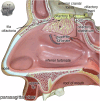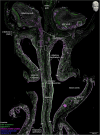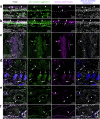Visualizing the human olfactory projection and ancillary structures in a 3D reconstruction
- PMID: 39516237
- PMCID: PMC11549439
- DOI: 10.1038/s42003-024-07017-4
Visualizing the human olfactory projection and ancillary structures in a 3D reconstruction
Abstract
Visualizing in 3D the histological microanatomy of the human olfactory projection from the olfactory mucosa in the nasal cavity to the olfactory bulbs in the cranial cavity necessitates a workflow for handling a great many sections. Here, we assembled a 3D reconstruction of a 7.45 cm3 en-bloc specimen extracted from an embalmed human cadaver. A series of 10 µm coronal sections was stained with quadruple fluorescence histology and scanned in four channels. A trained anatomist manually segmented six structures of interest in a subset of the sections to generate the ground truth. Six convolutional neural networks were then trained for automatic segmentation of these structures in 1234 sections. A high-performance computing solution was engineered to register the sections based on the fluorescence signal and segmented structures. The resulting 3D visualization offers several novel didactic opportunities of interactive exploration and virtual manipulation. By extrapolating manual counts of OSNs in a subset of sections to the calculated volume of the envelope of the entire olfactory epithelium, we computed a total of ~2.7 million OSNs in the specimen. Such empirically derived information helps assess the extent to which the organizational principles of the human olfactory projection may differ from those in mice.
© 2024. The Author(s).
Conflict of interest statement
The authors declare no competing interests.
Figures










Similar articles
-
Mapping the nasal airways: using histology to enhance CT-based three-dimensional reconstruction in Nycticebus.Anat Rec (Hoboken). 2014 Nov;297(11):2113-20. doi: 10.1002/ar.23028. Anat Rec (Hoboken). 2014. PMID: 25312369
-
Nasal airflow in the pygmy slow loris (Nycticebus pygmaeus) based on a combined histological, computed tomographic and computational fluid dynamics methodology.J Exp Biol. 2019 Nov 29;222(Pt 23):jeb207605. doi: 10.1242/jeb.207605. J Exp Biol. 2019. PMID: 31712355
-
Sectional anatomy of the olfactory pathways.J Neurosurg Sci. 2010 Mar;54(1):39-44. J Neurosurg Sci. 2010. PMID: 20436397
-
[Protocortex versus protomap: a perspective from the olfactory bulb].Rev Neurol. 2004 Jul 16-31;39(2):146-55. Rev Neurol. 2004. PMID: 15264166 Review. Spanish.
-
Survey anatomy and histological observation of the nasal cavity of Tupaia belangeri chinensis (Tupaiidae, Scandentia, Mammalia).Anat Rec (Hoboken). 2022 Jun;305(6):1448-1458. doi: 10.1002/ar.24793. Epub 2021 Oct 12. Anat Rec (Hoboken). 2022. PMID: 34605617 Review.
Cited by
-
On the Fila Olfactoria and the Cribriform Region of the Crocodylia.J Morphol. 2025 Feb;286(2):e70036. doi: 10.1002/jmor.70036. J Morphol. 2025. PMID: 39985331 Free PMC article.
References
-
- Killingley, B. et al. Safety, tolerability and viral kinetics during SARS CoV-2 human challenge in young adults. Nat. Med.28, 1031–1041 (2022). - PubMed
-
- Boscolo-Rizzo, P. et al. Psychophysical assessment of olfactory and gustatory function in post-mild COVID-19 patients: a matched case-control study with 2-year follow-up. Int. Forum Allergy Rhinol.13, 1864–1875 (2023). - PubMed
-
- Doty, R. L., Deems, D. A. & Stellar, S. Olfactory dysfunction in parkinsonism: a general deficit unrelated to neurologic signs, disease stage, or disease duration. Neurology38, 1237–1244 (1988). - PubMed
-
- Doty, R. L., Reyes, P. F. & Gregor, T. Presence of both odor identification and detection deficits in Alzheimer’s disease. Brain Res. Bull.18, 597–600 (1987). - PubMed
MeSH terms
LinkOut - more resources
Full Text Sources
Research Materials

